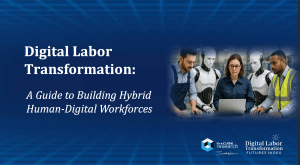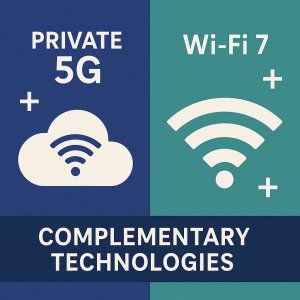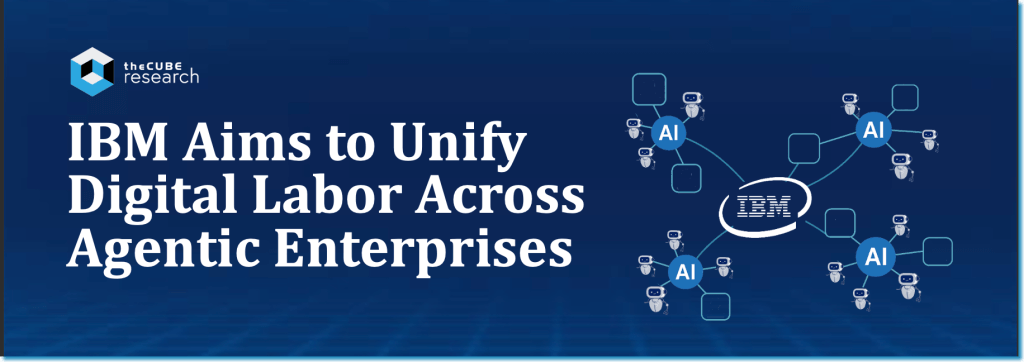
Here at theCUBE Research, we are dedicated to informing you about the latest advancements shaping the future of AI. In this research brief, we will examine IBM’s vision to help its clients employ trustworthy digital labor across their businesses, which was unveiled at their Think 2025 conference on May 6, 2025.
The overriding theme was “Ushering in the Agentic Enterprise,” which featured new capabilities designed to unify the agentic enterprise with an open and interoperable approach to creating and interconnecting agentic workflows. Essentially, it gives businesses the flexibility to create workflows using any agent, any platform, and any data from anywhere across the hybrid enterprise.
The underpinnings of this vision echo the strategy from over 25 years ago, which propelled IBM’s decade-long reign as the leader in enterprise e-business: deliver open, interoperable, and trusted platforms that allow for deep integration across the entire technology estate with unmatched choice and flexibility. Sound familiar?
It’s IBM déjà vu, in so many ways.
Will it work again?
The Golden Age of AI Agents
While not a first mover, IBM recognizes that we are entering what many call the “golden age of AI agents”—a pivotal moment in the evolution of enterprise technology, and more importantly, the rise of the digital labor marketplace. A powerful new market category is taking shape—one centered around intelligent digital workers who can reason, act, and collaborate with humans to enhance decision-making, streamline workflows, break down knowledge silos, and even operate autonomously when needed.
These digital workers (a.k.a. AI agents) go well beyond the GenAI-powered AI assistants we are accustomed to, actively shaping better outcomes in highly specialized business domains, not just assisting humans, but collaborating with them. They’ll empower businesses to do more than create predictions, generate content, identify patterns, and isolate anomalies. They can play out countless scenarios to understand the consequences of various actions, make better decisions, and solve problems. AI agents will become better equipped to comprehend ambiguous goals, respond to ever-changing conditions, and take action to achieve goals. In essence, they will help people know WHAT to do, HOW to do it, and WHY certain actions are better than others. AI agents promise a definitive improvement in ROI over generative AI assistants.
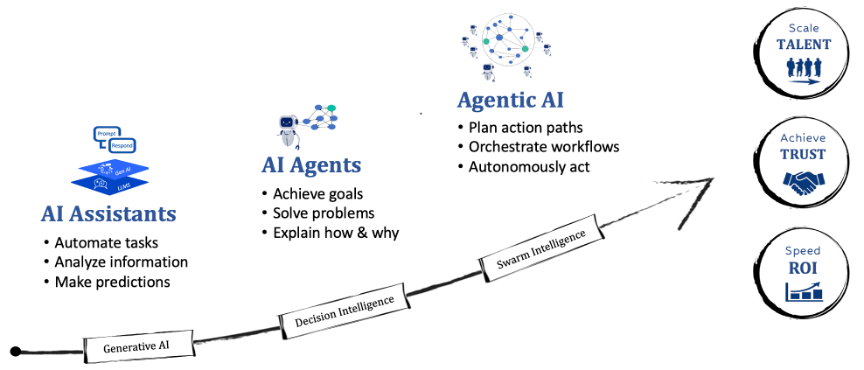
The ramp to ROI turns even more vertical when AI agents are wired together into adaptive agentic AI workflows, which integrate with other workflows, all guided by human expertise and know-how. This represents the transformative force, not independent or siloed AI agents operating without organizational context. Agentic AI promises to enable multiple specialized agents, of any origin, with their own goals, behaviors, policies, and knowledge to collaborate with each other and humans to achieve higher-order, organizational goals. Think “swarm intelligence,” where AI agents negotiate, cooperate, coordinate, or even compete to optimize outcomes in highly dynamic and uncertain conditions. The role of humans in this vision of digital labor is that of a supervisor and subject matter expert who defines goals, provides guidance, enforces guardrails, and evaluates outcomes.
This promise of value is driving unprecedented growth in research, public interest, and enterprise adoption, creating a significant new technology market category expected to expand at an astonishing 45% compound annual rate to over $50 billion by 2030.
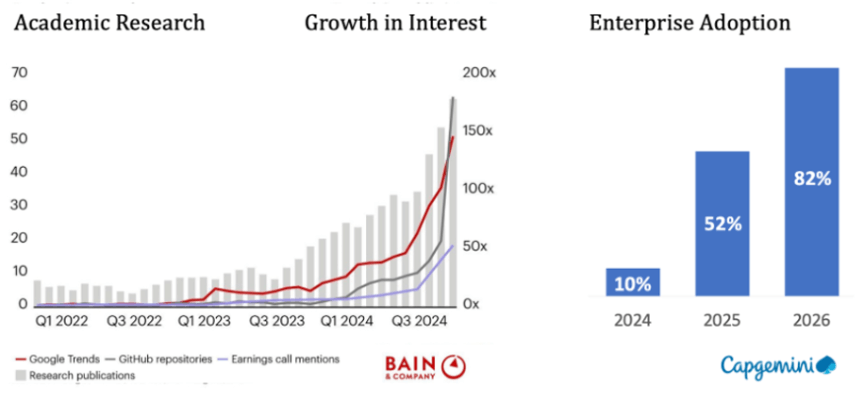
The rise of agentic AI marks the beginning of a new “super cycle” in business innovation that will reshape industries and markets everywhere. Unlike the cloud and SaaS era, where enterprise AI, analytics, and automation required heavy engineering investments and long ramp times, AI agents can now be rapidly created and integrated at significantly less cost. This promises to unleash a highly domain-specific digital labor that will empower human workers and consumers with new superpowers to conduct more meaningful activities. From this point, the ROI ramp into the future is potentially limitless, as there are countless highly vertical, domain-specific skill sets across the business and consumer spectrum to provide with new “superpowers”.
The future opportunity, especially for solution providers, shifts beyond the confines of IT budgets and high incumbency rates towards targeting labor spend — the largest and most untapped expense line in most industries. Studies show that traditional software typically captures only 5% of business spending, primarily within IT, while labor accounts for 60% of operating costs. The opportunity is ten times larger and ripe for transformation, with a strategic emphasis not just on building software, but on delivering digital workforces, particularly in markets where vertical, highly domain-specific skills exist.
And that future may be here sooner than you think.
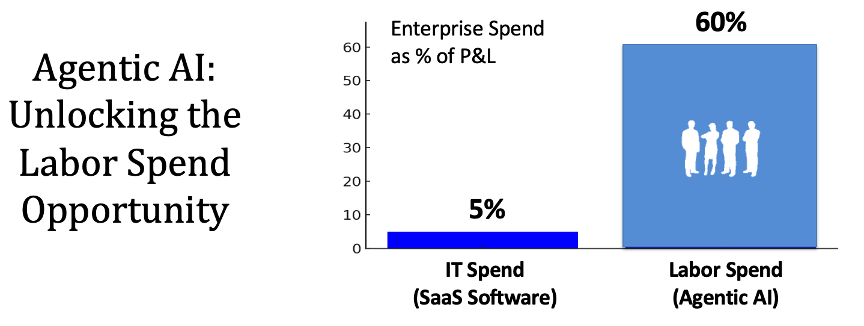
The Hybrid Agentic Enterprise
This promise of value, however, can only be achieved if digital workers collaborate with other digital workers, including those in other “departments”, regardless of skill and origin, leveraging all the appropriate resources and data needed to perform their jobs.
This reflects the critical imperative that over 70% of businesses have implemented. As Deloitte reported in a recent survey, the future of work requires human resources to evolve, shifting from siloed functions to a boundaryless collaboration across departments. Those that do are 1.6 times more likely to achieve desired business outcomes.
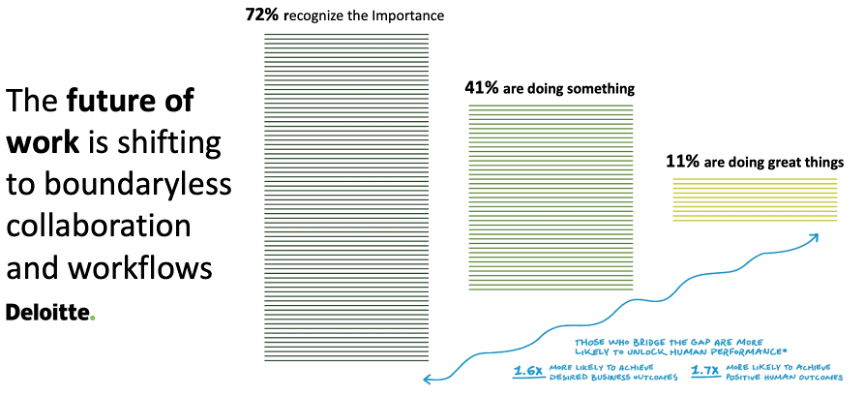
As this trend matures, it’s critical that AI agents are enabled to work alongside human workers to participate in these cross-functional, cross-department workflows.
Therefore, vendors and enterprises must learn from the past and avoid the proliferation of incompatible, closed, and siloed AI agents (and agentic workflows). Otherwise, they will create an additional layer of complexity and incur greater technical debt while significantly limiting the value of digital workers. Just as with humans, digital workers will come and go, and new workflows will emerge that need to seamlessly participate in an organization’s broader business processes. If AI agents are confined to rigid, isolated work environments, it will become impossible or very expensive to remediate this situation. With innovation cycles moving at warp speed, preventing this from happening approaches suicidal tendencies.
So, business leaders and enterprise IT architects need to recognize that, on the road to agentic AI, ditches on both sides can derail progress if not navigated carefully with long-term forethought. On one side lies the ditch of closed platformsand vendor lock-in—a world where organizations are compelled to build AI agents within proprietary silos, limiting flexibility, stifling innovation, and creating fragile dependencies. On the other side is the lack of interoperability, where disconnected apps, tools, data, clouds, and agents fail to collaborate effectively, resulting in a fractured ecosystem that cannot support the needs and aspirations of real-world enterprises.
Both challenges must be addressed for enterprises to realize the potential of a digital workforce. Without openness, enterprises lose choice and control. Without interoperability, agents cannot collaborate across domains or technologies, nor can agents from other platforms. The result is fragmentation: islands of automation that cannot coordinate, learn, or drive transformation at scale.In a recent survey by Tray.ai, 42% of AI agents will need to connect to eight or more data sources, driving 90% of enterprises to favor a hybrid approach that provides choice and flexibility in integrating acquired and home-built agents across enterprise landscapes. The study elevates a potential blind spot in how businesses plan to infuse AI agents into the existing infrastructures they rely on to run their businesses
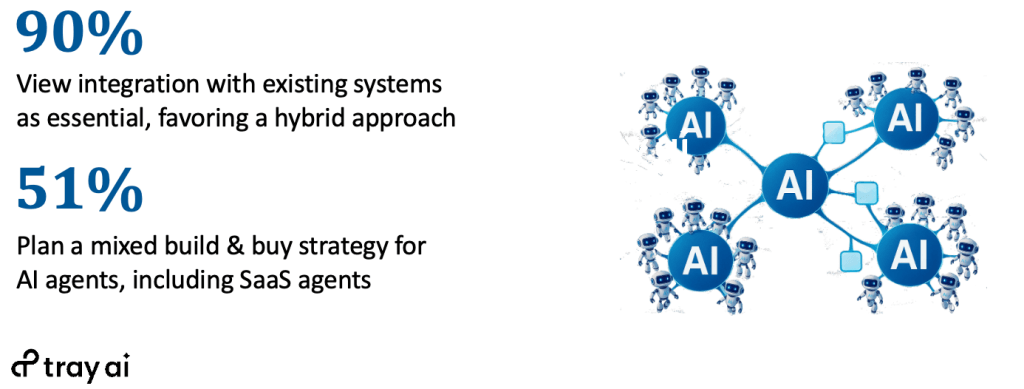
In the era of traditional software architectures, integrations between applications were typically point-to-point and heavily reliant on vendor-specific APIs. In the agentic era, however, organizations must coordinate diverse sets of digital workers (AI agents) built on varying frameworks, hosted in different environments, and developed using various models. These agents need to:
- Execute domain-specific skills
- Communicate and collaborate
- Share context across workflows
- Be aware of other agents decisions
- Operate within broader business processes
The most strategic agent orchestration platforms are those that enable the plug-and-play composition of agents, regardless of where they were built or which LLMs or toolkits power them. Any agent, any platform, any workflow, any cloud.
In this context, openness is the connective tissue that binds the agentic enterprise together. And with interoperability, your digital workforce can scale, be trusted, and be more easily adopted across your organization.
IBM stressed that agentic AI is not just about building smarter agents—it’s about building agents that can work with other agents. Open standards, shared protocols, and semantic layers are emerging as foundational elements. Only when agents, regardless of where or how they were built, can plug into an open operational fabric will the vision of a composable, resilient, and collaborative digital workforce truly take shape. Until then, the road forward remains narrow—and too easy to drive into a ditch. This concept was at the heart of IBM’s announcement at Think 2025.
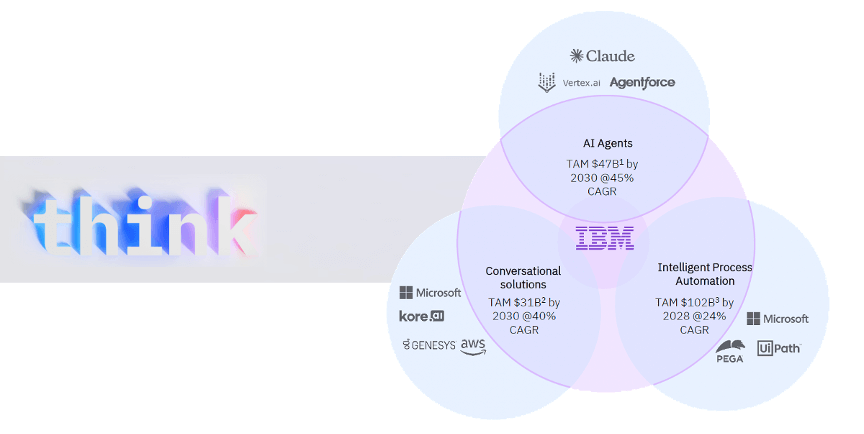
What IBM Announced
At Think 2025, IBM unveiled various advancements to unify the agentic AI enterprise landscape, simplifying the integration of trusted digital workers into and across its clients’ business workflows. These announcements strengthen IBM’s enterprise AI capabilities anchored in the principles of openness, trust, and enterprise domain expertise while doing so in an ecosystem-friendly manner.
Rob Thomas, IBM’s SVP of Software and Chief Commercial Officer, simplified their strategy:
“Over the next three years, 1 billion agents will be built, and they will need to be able to work with each other seamlessly.”
As did IBM Chairman and CEO, Arvind Krishna, who emphasized IBM’s strategy to support the decisions of its customers, recognizing that it’s a hybrid world:
“We help our clients integrate. We want to meet them where they are.”
These statements underscore IBM’s commitment to what has historically worked so well for the company, leading with an open and interoperable value proposition that allows businesses to integrate AI agents from various providers, regardless of their origin.
The announcements at Think 2025 mark a pivotal moment in the evolution of IBM’s AI strategy, designed to enable AI agents to navigate the enterprise, execute tasks, and simplify interactions across fragmented workflows. They look to address the growing need for an orchestration layer to bridge the complexity of hybrid clouds, legacy systems, SaaS ecosystems, and a new generation of intelligent AI agents.
At the center of attention was IBM watsonx Orchestrate, newly positioned as “the orchestrator of the Agentic Enterprise.” IBM proclaimed that it was delivering the missing layer in enterprise AI: an open, interoperable semantic control plane capable of putting agents to work across the entire data and technology stack, regardless of origin.
At the core of watsonx Orchestrate is a semantic engine that understands user goals, breaks them into executable tasks, assigns them to the right agents, and ensures contextual continuity across systems. Essentially, it acts as a supervisor and coordinator for a distributed digital workforce. This architecture reflects IBM’s broader strategy: enabling AI agents to operate in open, interoperable ecosystems—supporting multiple frameworks, connecting to a wide range of enterprise applications, and aligning with open communication protocols.
Think of it as a semantic operating system for enterprise agents—an intelligent layer that translates goals into agent actions, routes tasks to the right systems, and manages context across processes. It acts as a supervisor, planner, and coordinator for an expanding web of domain-specific and general-purpose agents. Its capabilities span:
- Goal Interpretation: Understanding what the user wants
- Task Decomposition: Mapping goals to discrete agent actions
- Agent Routing: Delegating to the right agents based on skills and context
- Hybrid Integration: Connecting to public cloud, on-prem, and SaaS resources
- Multi-agent collaboration: Cooperative execution among distributed agents
In short, watsonx Orchestrate is the semantic glue that binds agents together with enterprise systems—much like middleware did in past generations of enterprise software.
With multi-agent collaboration, watsonx Orchestrate can now enable agents to coordinate tasks dynamically, assign responsibilities to one another, and execute complex workflows that span multiple systems. Its capabilities include:
- Agentic Orchestration: Coordinate and automate AI agents to handle complex, multi-step workflows, allowing them to collaborate seamlessly across diverse tools, data sources, and IT environments.
- Pre-built Agents: Tailored to specific business domains and use cases, equipped with out-of-the-box skills and integrations—specialized for functions such as HR, procurement, sales tasks, procure-to-pay, finance, and customer care.
- Agent Creation: Accelerate agent creation with user-focused tools, including intuitive no-code builders that enable agents in minutes, to advanced capabilities for developers for more sophisticated agents.
- Domain-specific Agent Catalogs: Featuring pre-built, custom-built, and third-party agents—all easily customizable by users or developers that can be visually integrated into unified, cross-functional workflows.
- Agent Observability & Governance: Discover and understand agents across the enterprise, offering real-time performance dashboards, compliance guardrails, and usage insights via watsonx.governance.
- Making data ready for agentic AI: Enables data professionals to build intuitive data pipelines, store contextual information, categorize content, and define semantic relationships via the introduction of watsonx.data integration.
- Agent Knowledge & RAG Tools: facilitating more accurate and effective AI agents fueled by knowledge, context, and perspective via the introduction of watsonx.data intelligence..
- Agent Connectors: Integrate over 80 popular enterprise systems and SaaS applications, ranging from Workday and Salesforce to Oracle and Microsoft apps, providing native connectivity across the existing application stacks.
- Gen AI / LLM Choice: Agents can tap into multiple foundation models based on their use cases with watsonx.ai—including IBM Granite, LLaMA, Mistral, Flan-T5, and third-party open-source models on Hugging Face, as well as specialized models for things like causal AI via partnerships with causaLens, Geminos, and Howso.
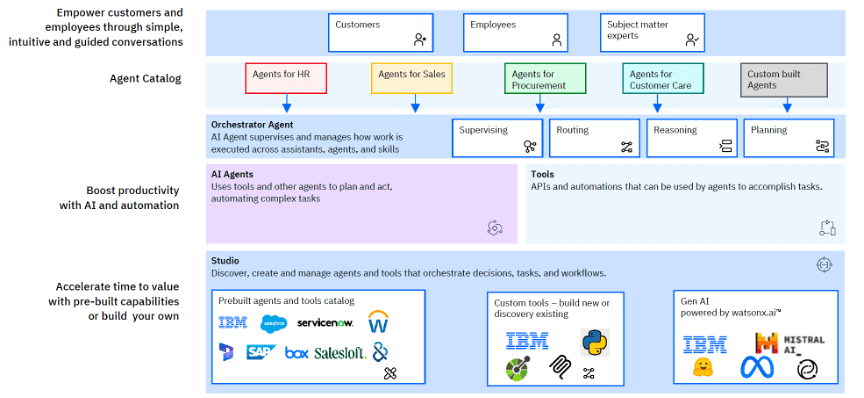
What IBM hopes is that its commitment to openness and interoperability at both the technical and ecosystem levels will set it apart in this transformative era of agentic AI.
Unlike competitors who often push for vertical integration or platform lock-in, IBM is betting on interoperability. It positions itself as the connective layer that integrates AI agents into the fabric of existing systems, rather than forcing enterprises to rip and replace. IBM’s key differentiator is not owning the stack, but orchestrating across it, including Microsoft, AWS, Oracle, SAP, Salesforce, and now even open-source agent frameworks. That makes it a strong contender for enterprises looking to unify fragmented AI investments without migrating away from existing AI, cloud, or analytics partners.
IBM is doubling down on its vision of open, interoperable AI with the launch of IBM Agent Connect. This new partner program represents a strategic approach to create a more connected, composable, and scalable agentic ecosystem for enterprises. IBM partners—whether SaaS vendors, system integrators, or niche AI developers—can now build directly into watsonx Orchestrate and list their agents in the Agent Catalog. IBM provides them with integration specs, development tools, and go-to-market support. This democratizes access to the platform and dramatically increases the variety of agents and use cases available to customers.
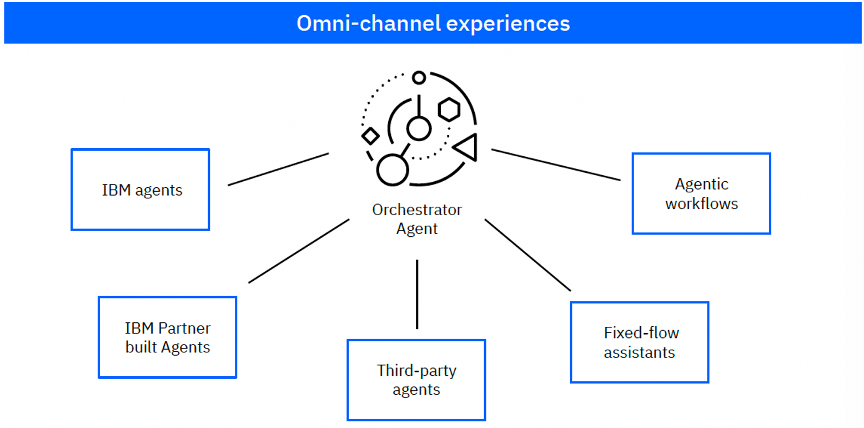
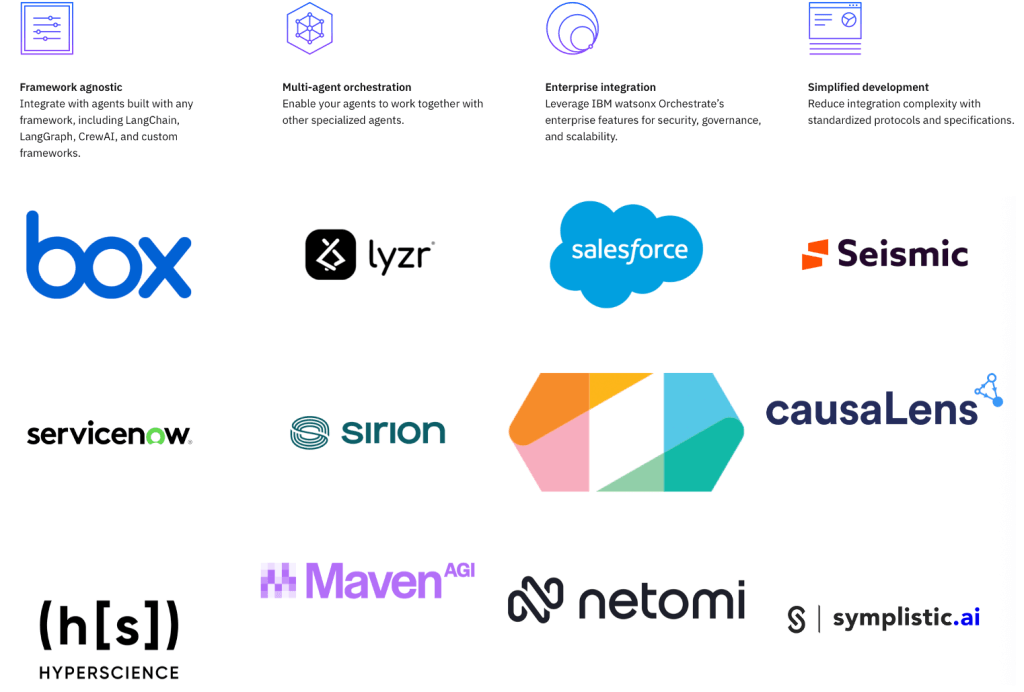
At its core, Agent Connect is an agent-agnostic framework that enables developers and partners to integrate any agent, built on any agentic stack, into the watsonx Orchestrate platform. Instead of enforcing rigid architecture, IBM concentrates on semantic orchestration, allowing developers to create the agents they desire while IBM manages execution, routing, and observability. This reduces the barrier for integrating best-of-breed agents without lock-in.
It also enables enterprises to deploy and scale agentic systems with the same rigor applied to IT infrastructure. It aligns with IBM’s enterprise-grade governance model, which brings built-in scalability, auditability, and role-based access control. Agent Connect is a vital enabler for IBM’s hybrid agentic AI vision by eliminating integration friction and facilitating trustworthy multi-agent interoperability. To grow this agent ecosystem, IBM is launching a partner program for SaaS vendors, system integrators, and AI developers. Partners can build directly into Orchestrate, list agents in the Agent Catalog, and access IBM’s integration tools and go-to-market support, expanding the variety and reach of enterprise-ready agents.
Collectively, they hope to become the universal “digital labor HR department” by leading the industry in open agentic AI capabilities that will better equip enterprises to utilize any agent, any data, any platform, and any workflow from anyone in their agentic AI architectures, all through an omnichannel experience.
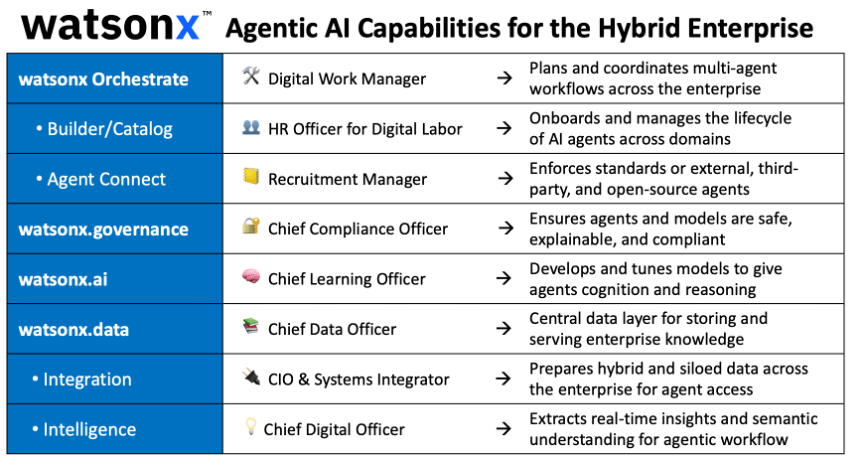
AnalystANGLE
IBM’s agentic AI strategy focuses less on driving innovation and more on addressing the pragmatic needs of the marketplace, particularly its enterprise client base. It recognizes the realities of fragmented business processes, complex enterprise stacks, and the heterogeneous nature of vendor ecosystems. It also anchors on perhaps the most critical point about agentic AI: digital labor will become highly vertical and domain-specialized, requiring specialized agents that only the “long tail” of the agent ecosystem can deliver.
The announcements at Think 2025 signify a bold and familiar strategic posture: championing openness and interoperability and IBM as the orchestrator of the hybrid agentic enterprise, where agents built with any framework, running in any environment, can collaborate—any agent, any data, any workflow, from anywhere.
This isn’t the first time IBM has invested significantly in openness and interoperability. More than two decades ago, in the early days of e-business, IBM championed interoperability through its open standards-based WebSphere platform. Over the next decade, IBM doubled its software revenue from $13B to $26B, capitalizing on its position as a first mover in open standards for e-business.
More recently, IBM repeated this play with its hybrid cloud strategy anchored on the Red Hat OpenShift platform, which delivered flexibility and interoperability across on-prem, public, and multi-cloud environments. Since the acquisition of Red Hat, IBM’s software revenue has increased by $3.6 billion, expanding the software share of total IBM revenue by 12 points to 42%. Both strategies unlocked substantial business value by aligning with the practical nature of real-world IT, where choice and compatibility mattered most.
Now, IBM is applying the same playbook to AI agents. Rather than competing to “own” the full agentic stack, IBM is creating the connective tissue that allows enterprises to compose intelligent workflows across heterogeneous systems, apps, clouds, and agents. IBM isn’t just technology and services—it’s enabling an open agent ecosystem.
It’s IBM déjà vu, in so many ways.
Can the same principles that powered its rise in web middleware and hybrid cloud now establish it as the enterprise standard-bearer in the agentic era?
The historical parallels are strong, and the opportunity is massive, as openness is arguably more critical to the success of agentic AI—and therefore digital workforces—than it was during the e-business and cloud eras. If IBM executes with the same focus and consistency that it demonstrated in the past, the answer may very well be yes.
This begs the question: Is IBM unique in its ability to support plug-and-play composition, orchestration, and governance across a hybrid agentic enterprise?
To help answer this question, theCUBE Research has created a “starter” framework to evaluate how interoperable various agentic platform players are—in practice, not just in promise. It’s our view that the evaluation must start with five core capabilities:
- Semantic Layer Support—Does the platform provide a shared understanding of workflows, intent, decision chains, and context that agents can use regardless of their source?
- Open Protocols, LLMs, and APIs—Does the platform use or support standards, open-source schemas, and a comprehensive catalog of domain-specific models to ease agent integration?
- Cross-Agent Orchestration – Can agents from different platforms work together in a coordinated way inside and outside a platform, while maintaining observability, governance, and risk management policies?
- Extensible Adapters—How rich are the platform’s plug-ins, connectors, or frameworks that enable the integration of agents across a heterogeneous enterprise technology landscape?
- Composability —Does the platform enable non-technical users to import, orchestrate, and adapt the use of external agents in custom workflows regardless of origin?
When evaluating watsonx Orchestrate, in the context of the watsonx platform, against this framework, they score very well.
It includes a semantic control plane that enables agents to understand tasks, decisions, intent, and context across workflows. It supports multi-agent orchestration, goal decomposition, and coordination, providing a robust semantic mediation layer that allows different agents to “speak the same language” operationally.
Support for open protocols is world-class, supporting standards like REST, OpenAPI, and Model Context Protocol (MCP) for consistent agent-to-agent and agent-to-application communication. The platform also promotes LLM flexibility, offering access to 3rd-party models from Meta, Mistral, Google, and Hugging Face’s ecosystem of open-source models. Combined with an API-first architecture for integrating existing enterprise systems, and any Cloud via Red Hat OpenShift.
At Think 2025, IBM demonstrated its ability to orchestrate agents from any vendor, including open-source frameworks like LangGraph and CrewAI. The platform functions as a “multi-agent supervisor, router, and planner,” coordinating multiple agents from different sources, routing tasks, managing dependencies, and aligning on shared goals. This is essential for creating complex, multi-step processes.
The Agent Catalog, SDKs, and the new Agent Development Kit (ADK) bring extensibility to life, enabling developers to plug in their agents and extend platform capabilities. IBM also allows partner-built agents and supports multiple hosting environments and development stacks, including over 80 enterprise platforms and 150 pre-built agents of various origins.
Finally, IBM targets developers and business users with dual interfaces: a no-code Agent Builder for fast deployment among tech-savvy business users and a pro-code studio for developers. This dual approach is essential for democratizing agent adoption across the enterprise, enabling what is likely the industry’s richest composability.
We also evaluated the top 10 suppliers of agentic AI orchestration platforms and how IBM is leading the pack, positioning it well to excel in the hybrid agentic enterprise space.
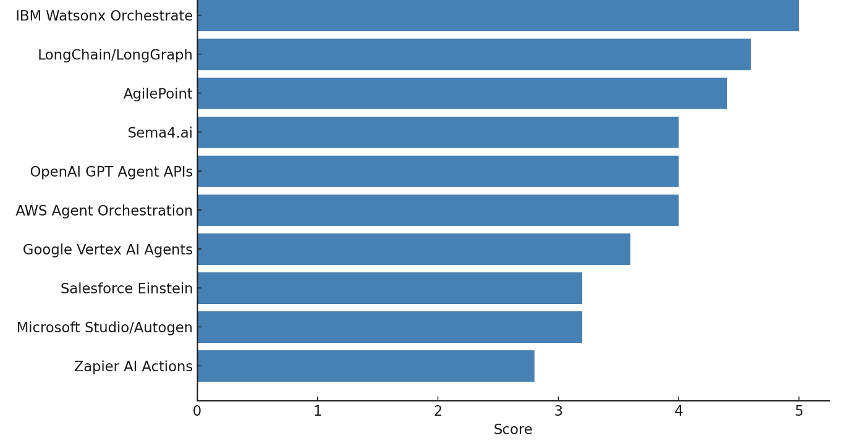
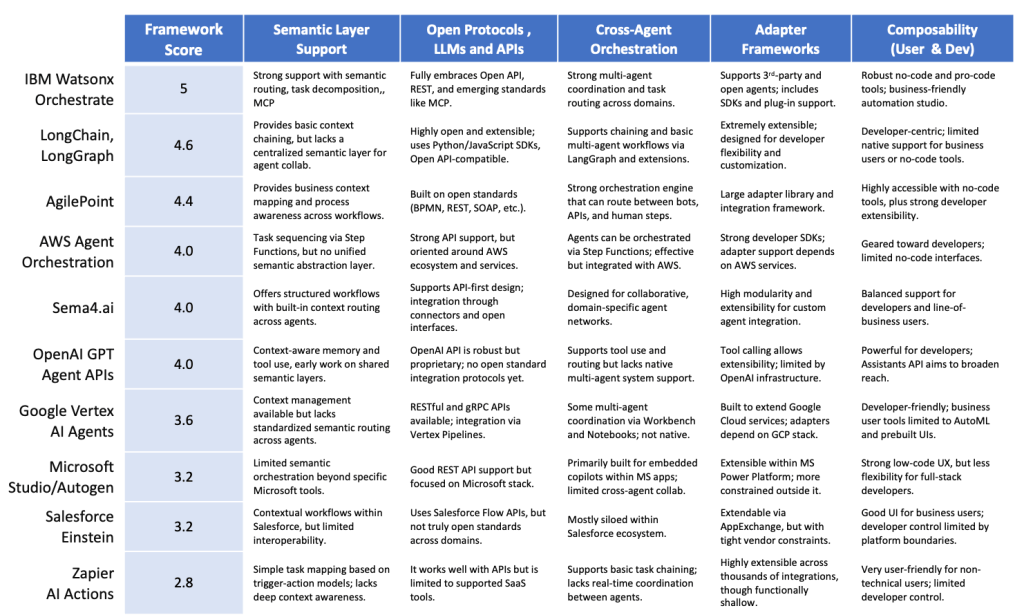
Our perspective here at theCUBE Research is that in the emerging “golden age of AI agents,” the ability of these agents to collaborate, regardless of where they were built, what language model powers them, or where they are deployed, is a strategic imperative. Enterprises are inherently complex environments. They span multiple clouds, rely on a patchwork of SaaS tools and legacy systems, and are increasingly deploying AI across a variety of domains—from IT and HR to finance and customer service. No single vendor can, or should, own the entire agent stack.
That’s why agent openness and interoperability should become one of the most critical success factors in evaluating agentic AI platforms. These factors will enable organizations to build adaptive, best-of-breed, future-proof ecosystems of digital workers while preserving the “digital HR functions” of governance, observability, and business control.
While IBM excels with its commitment to open and interoperable agents, it’s important to recognize that numerous other criteria should be evaluated. The platform is still maturing in several areas compared to alternatives in the marketplace. Areas to keep an eye on include usability, empowerment of business users, and especially the infusion of AI decision intelligence. It’s our view that while openness and robust interoperability create a strategic foundation, in the end, AI agents need to be able to help humans achieve goals, plan, reason, make decisions, and problem-solve. To compete in more sophisticated agentic AI use cases where decision intelligence is critical, IBM must beef up its Granite AI models and watsonx platform with more advanced reasoning technologies. In doing so, it will enable business users to rely on trusted AI agents to conduct counterfactual analysis, evaluate ‘what if’ scenarios, understand why things happen, and to explain (or document) their decisions. In this space, IBM has some ground to make up against other agentic AI providers such as SAS, Microsoft, and AWS, who are actively prioritizing the AI reasoning space using advanced analytics, knowledge graphs, and causal AI.
What to Do and When
Based on the past, IBM’s agentic AI playbook positions them effectively to lead in delivering solutions that can integrate digital labor across the hybrid agentic enterprise.
While other considerations, such as AI decision intelligence, are important, the foundational strategy to support an open, future-proof agentic architecture should be attractive to most large enterprises.
We’ll see if IBM can translate its head start in this area into a long-term winning strategy.
Readers of this research brief may also find the following of interest:
- Agentic AI: Why Architecture Matters
- IBM & causaLens: Agents that know why
- AI Agent Builder Summit: Speed your way to ROI
Finally, as always, contact us if we can help you on this journey by booking a briefing here or messaging me on LinkedIn.
Thanks for reading. Feedback is always appreciated.

